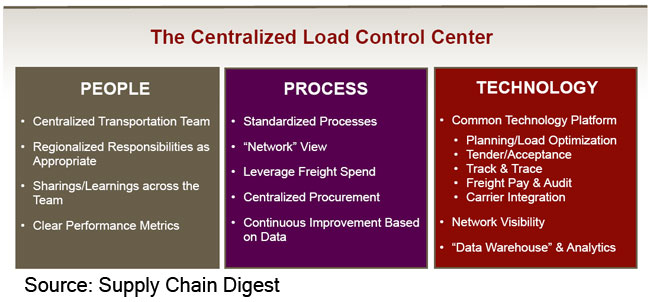In fact, the decision to build a centralized transportation function remains the most common driver of adoption for Transportation Management Systems (TMS). But as many companies now have years of experience in a centralized model, the concept is continuing to expand and evolve.

For example, many Load Control Centers were first developed to support a given business or division of a corporation. But now, the concept is expanding in some companies to a “shared services model,” in which a single, centralized transportation group is set up to service the needs of multiple business units or divisions.
The “shared services” concept makes sense, as there are often many efficiencies to be gained by leveraging people, transportation spend, and load linking across more volume. But it’s not that easy. Just as with plants or DCs that are reluctant to give up shipping control to a centralized LCC, business units may be reluctant to give up their own logistics destiny to a shared services group – especially if it grows out of another business unit that may deal with very different products or customers. Consider an aluminum company, for example, that ships consumer products to retail and also rolls of aluminum to manufacturers on flatbed trucks. Should those two transportation operations be combined? That’s much less clear.
So, a shared services LCC may need to acquire and build a very diverse set of transportation planning and execution skills – and to operate truly “independent” from the division from which it arose.
Accounting is also Tricky
Another real challenge of the “shared services” model is the accounting.
In any sort of shared service set-up, different business units or product lines are “billed” for the cost of the freight itself and usually the cost of providing the services – in fact, the shared services organization often looks quite a lot like an internal 3PL or managed services provider.
The question, of course, is how these costs will be calculated and “allocated.”
This can be especially tricky if shipments or loads are combined between business units. If two business units link a load from Ohio to New Jersey and back at a reduced rate from a carrier, how will those savings be allocated or shared? How will “overhead” of the shared transportation group be allocated as well?
These are the same types of questions that have bedeviled collaboration efforts between companies, and can be a source of dispute within the company as well. As a result, some companies are adopting TMS platforms of the same type used by traditional 3PLs to manage transportation for others.
What does the 3PL module add? In a nutshell, the ability to see “buy prices” and “sell prices,” and to be able to allocate the costs between “customers.” This trend has been happening for some time in the distribution area, as companies that operate shared DCs across businesses acquire “3PL billing modules” to add on to a traditional WMS to deal with very similar sort of cost tracking and allocation requirements.
The Global Load Control Center
In addition to expanding the traditional Load Control Center concept to encompass multiple divisions in a shared services model, the LCC is also moving to become more global in nature, rather than the mostly domestic orientation most have had to this point in time.
In many companies, global logistics operates somewhat independent from domestic transportation management. This is especially true in the area of global trade compliance, which often operates totally outside the logistics function, under such areas as legal or finance.
More and more companies are looking to combine global and domestic operations in a global Load Control Center as, for many, the percent of international transportation spend continues to rise.
This move to a global LCC is bolstered by the much greater support for full, end-to-end moves in transportation planning and execution offered today by leading TMS vendors. Until the fairly recent past, there were not really any systems that were capable of modeling and optimizing these multi-leg, mode and carrier moves. The good news is, while those capabilities are still evolving, several providers now provide such end-to-end capabilities, making the goal of a true global LCC much more achievable.
How do you see the Load Control Center evolving? Are many companies moving to a shared services model? Are we seeing true global LCCs? Let us know your thoughts at the Feedback button below.
SCDigest is Twittering!
Follow us now at https://twitter.com/scdigest